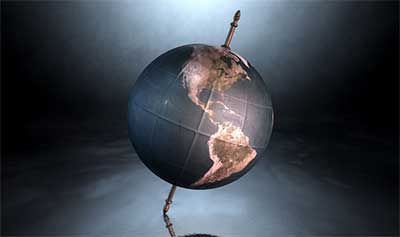Date : 20/06/2023
Relevance –
- GS Paper 1 – Physical Geography – Earth and its motion
- GS Paper 3 - Environmental Impact
Keywords – Earth’s dynamic axis, groundwater depletion , Mid latitude regions
Context –
- Groundwater extraction, a process extensively used to meet human water demands, has been found to significantly impact the Earth's axis, causing it to tilt towards the east.
- A recent study conducted by scientists at Seoul National University has shed light on the previously unconsidered role of groundwater depletion in affecting the planet's rotation.
- The research highlights the consequences of this phenomenon on sea levels and underscores the significance of addressing groundwater management practices.
Understanding Earth's Wobble: Earth's Dynamic Axis
- The Earth's axis exhibits a wobbling motion rather than remaining fixed, akin to a spinning top slightly off-kilter.
- Various factors contribute to the axis' movement, including weather patterns, seasonal changes, the molten core, and powerful hurricanes.
- Scientists track this motion relative to astronomical phenomena, such as the centers of bright galaxies or quasars.
Role of Water and Groundwater Depletion:
1. Water's Impact on Earth's Rotation:
- Previous studies have shown that water movement globally influences the Earth's rotational dynamics.
- The 2016 study revealed how water circulation contributed to the Earth's axis wobble.
2. Groundwater Extraction Revealed:
- Scientists at Seoul National University, led by Professor Ki-Weon Seo, built a climate model linking the Earth's axis shift with water movement, including melting ice caps, glaciers, and groundwater.
- Initial model simulations did not match the observed axis drift until groundwater extraction was included.
- Groundwater pumping was identified as a previously unrecognized cause of the rotation pole drift.
Implications and Findings:
1. Sea-Level Rise and Groundwater Depletion:
- The study estimated that approximately 2,150 billion tonnes of groundwater were pumped into the oceans between 1993 and 2010, resulting in a sea-level rise of 6.24 mm.
- The location of groundwater depletion is a crucial factor impacting the magnitude of axis drift.
2. Mid-Latitude Regions Most Affected:
- The model revealed that groundwater extraction from mid-latitude areas had the most substantial influence on the Earth's axis drift.
- Northwest India and western North America, both mid-latitude regions, experienced the highest levels of groundwater redistribution.
Groundwater Depletion and Regional Concerns:
1. Groundwater Depletion in India:
- India has been grappling with significant groundwater depletion, particularly in the last decade.
- Nearly 95% of the extracted groundwater in India is used for agricultural irrigation.
Conclusion:
The recent study highlights the previously overlooked impact of groundwater extraction on the Earth's axis drift. Groundwater depletion, along with other factors, contributes to the planet's wobbling motion. Additionally, the study emphasizes the link between groundwater extraction, sea-level rise, and the importance of effective groundwater management practices. Understanding these implications can aid in developing sustainable strategies to mitigate the adverse effects of groundwater extraction on the Earth's dynamics.
Probable Question for Mains Examination –
- Question 1. The study conducted by scientists at Seoul National University highlights the impact of groundwater extraction on the Earth's axis drift and sea-level rise. Discuss the potential implications of groundwater depletion on the environment and suggest measures to address the challenges associated with sustainable groundwater management. (10 Marks, 150 Words)
- Question 2. The wobbling motion of the Earth's axis, influenced by various factors including groundwater extraction, has significant consequences for global climate patterns and sea-level rise. Analyze the specific role of mid-latitude regions, such as northwest India and western North America, in groundwater redistribution and its impact on the Earth's axis drift. Also, suggest policy interventions to promote sustainable groundwater practices in these regions. (15 Marks, 250 words)
Source – The Hindu







